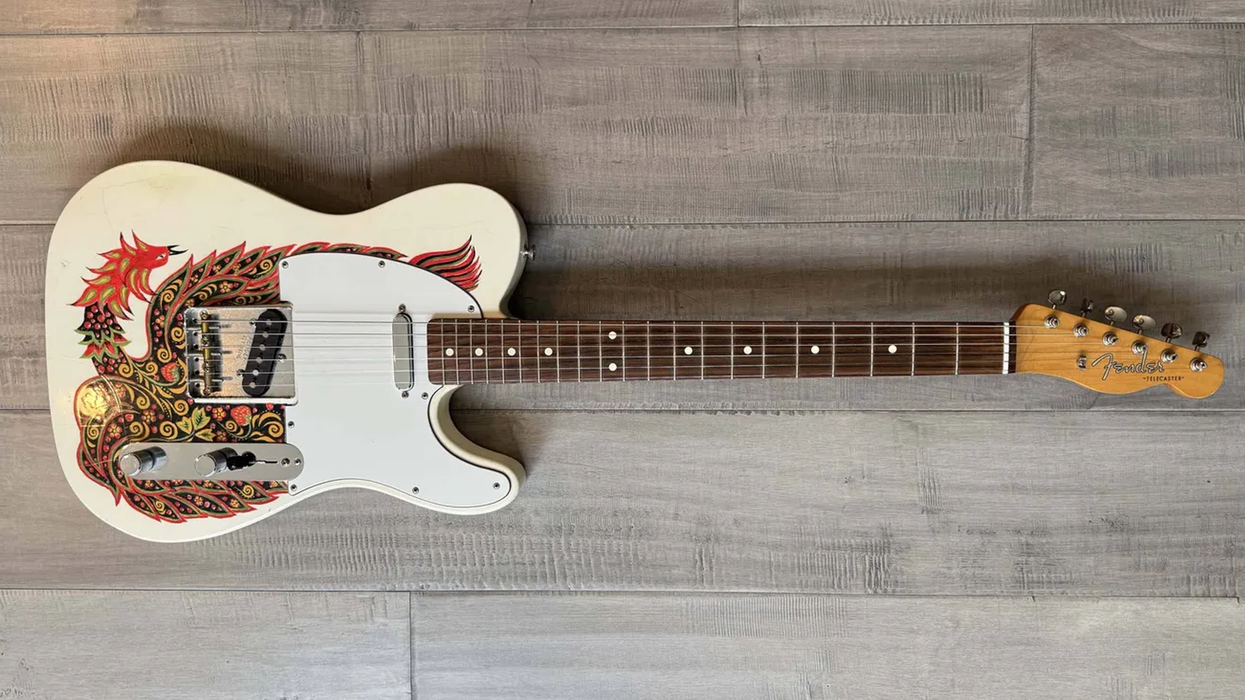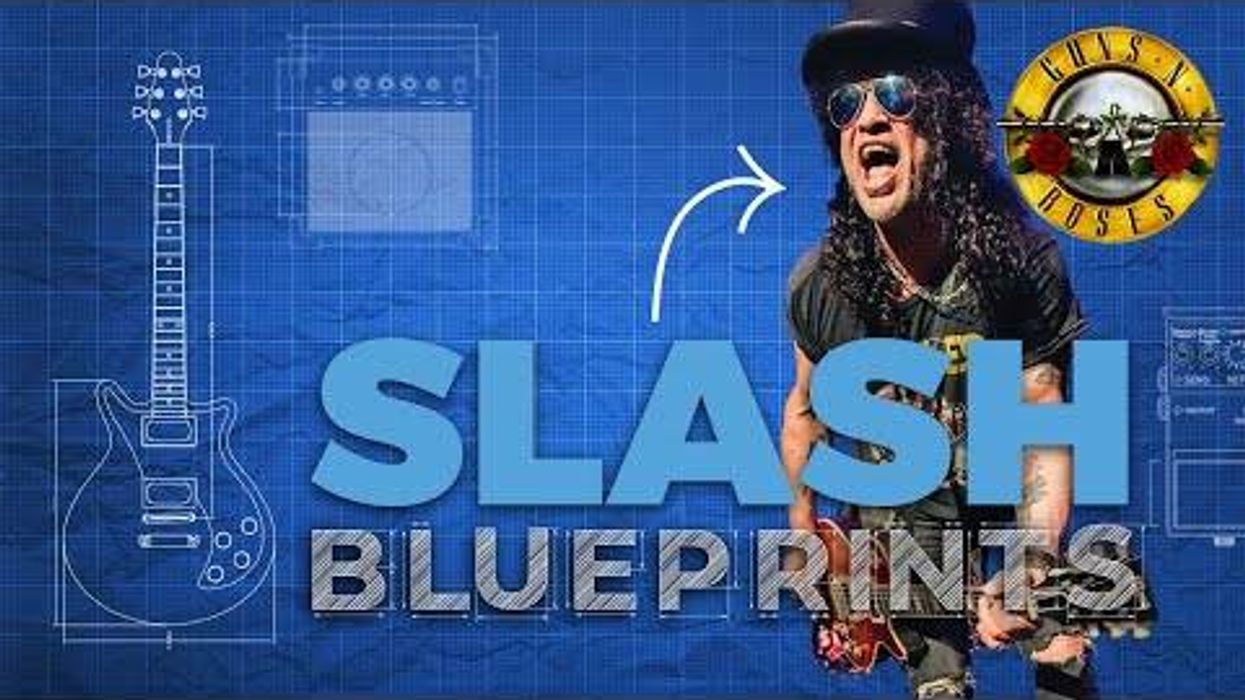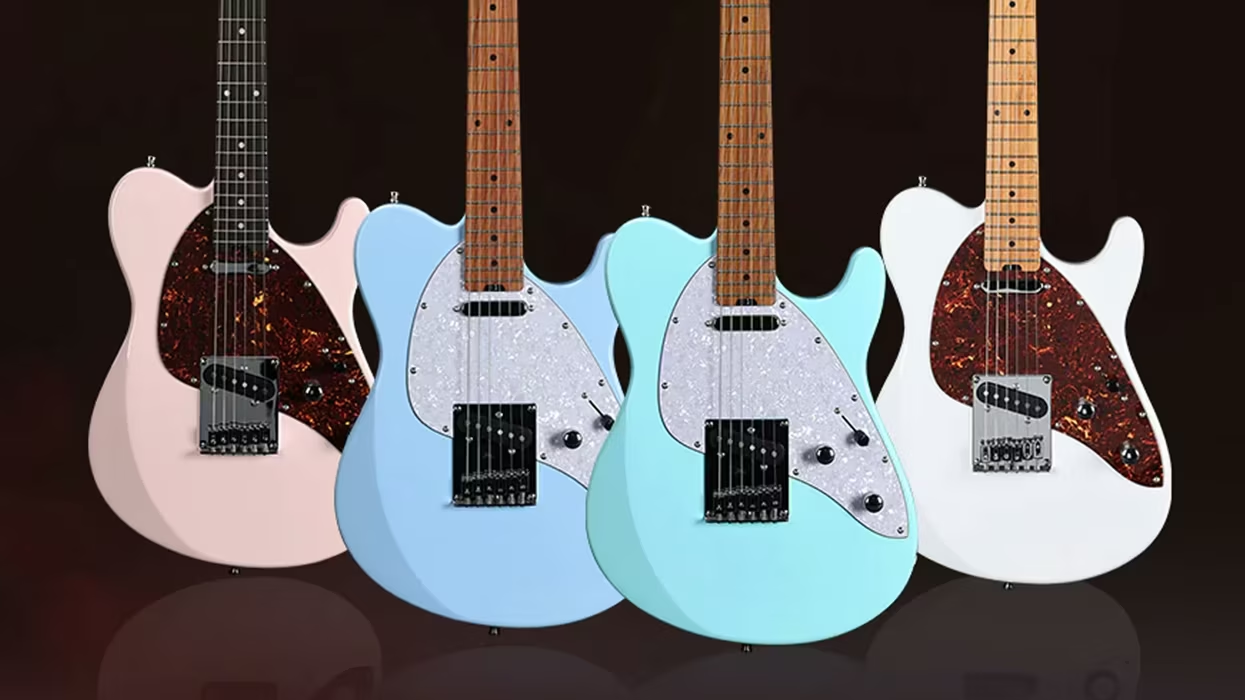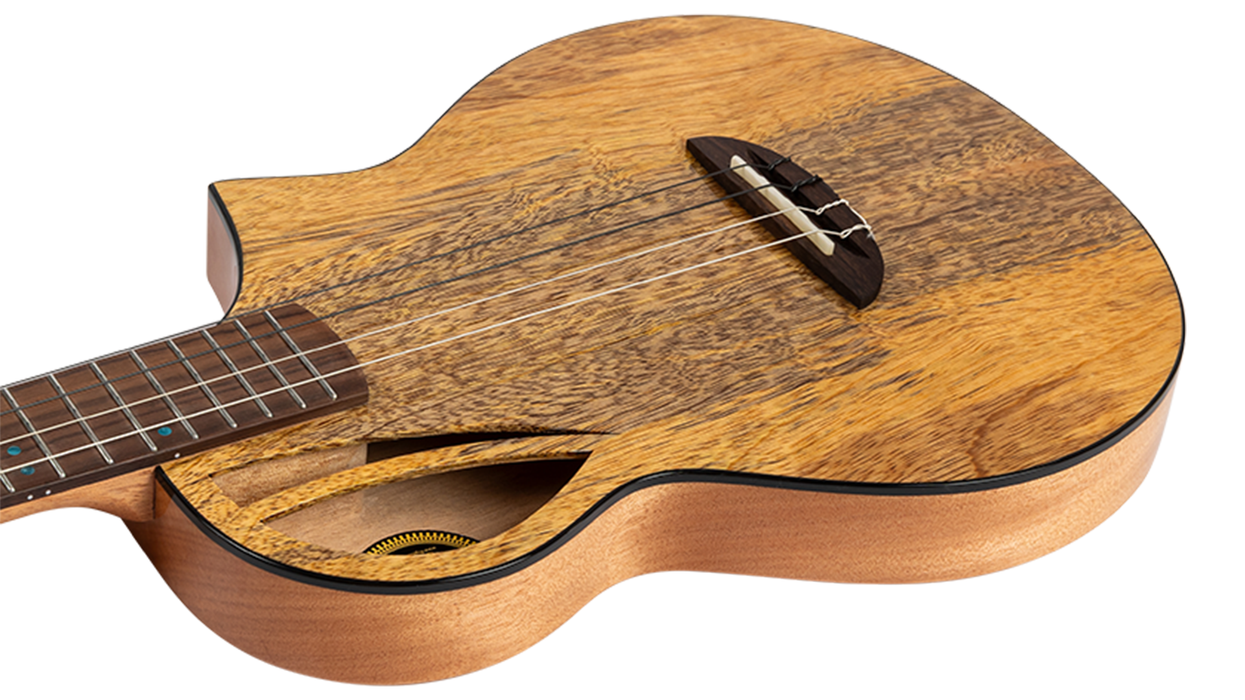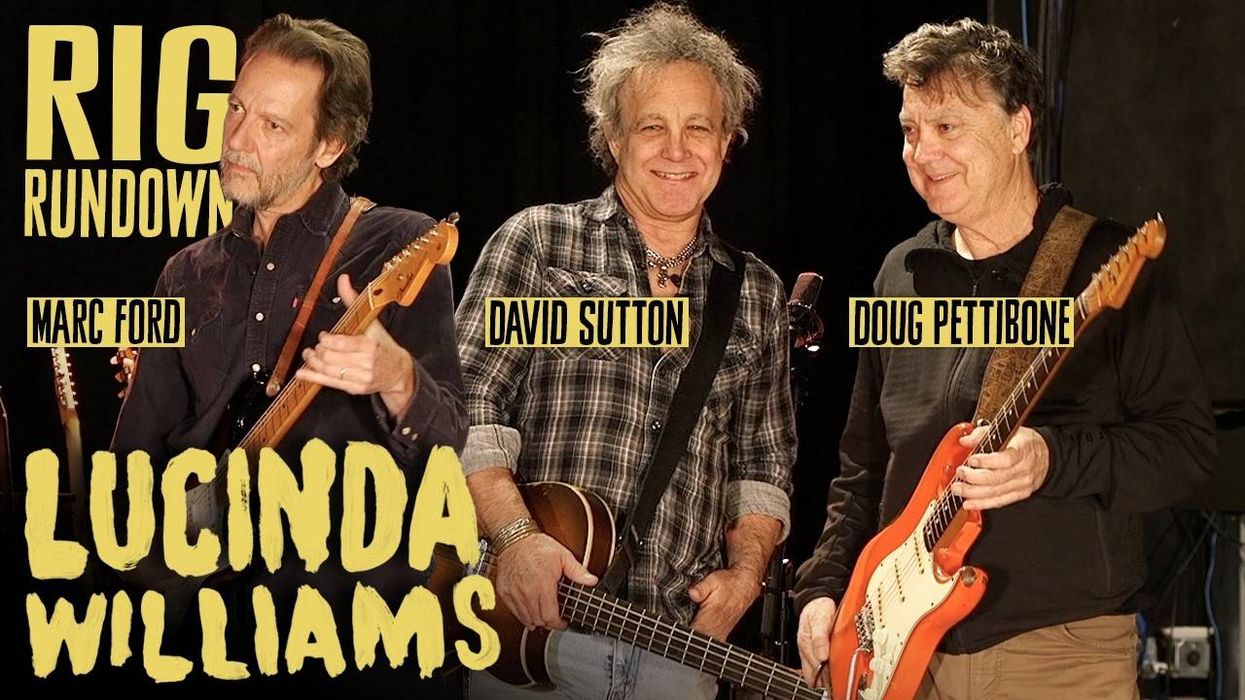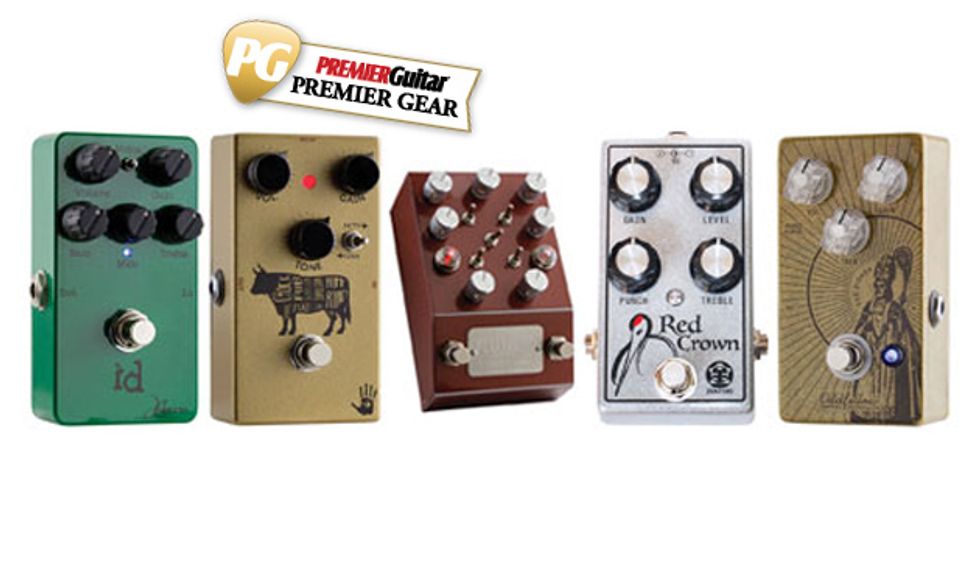
Overdrives are often the point around which a whole pedalboard pivots, making the variables and differences between these devices critical. And whether you consider the mysterious harmonics and compression they can add to an analog delay, the way they give a clean 6L6 amp the ringing grit of EL34s, or the way they can heap mass on a germanium fuzz, overdrives can go beyond just adding a spoonful of Buddy Guy attitude to your tone.
In reviewing these five recent stomps, we took this broader outlook on the overdrive’s role in your rig. And while we primarily evaluated each for its standalone performance (indeed, some of these pedals left us convinced we’d need little else), we also paid attention to how they interact with such common effects as fuzz and delay.
You’ll see familiar and classic lineage and inspiration among our selections, as well as a few unique circuits that evolve the overdrive concept along interesting trajectories. Each showed us something about the possibilities of this often overlooked effect. If you think you’ve got the world of OD all figured out, we might just have a few surprises in store.
Click onto the next page or select the dirtbox you want to explore next:
JColoccia ID
Mojo Hand Sacred Cow
Oddfellow The Bishop
Zen Zero Red Crown
Pettyjohn PettyDrive
All Review Demos On One Page
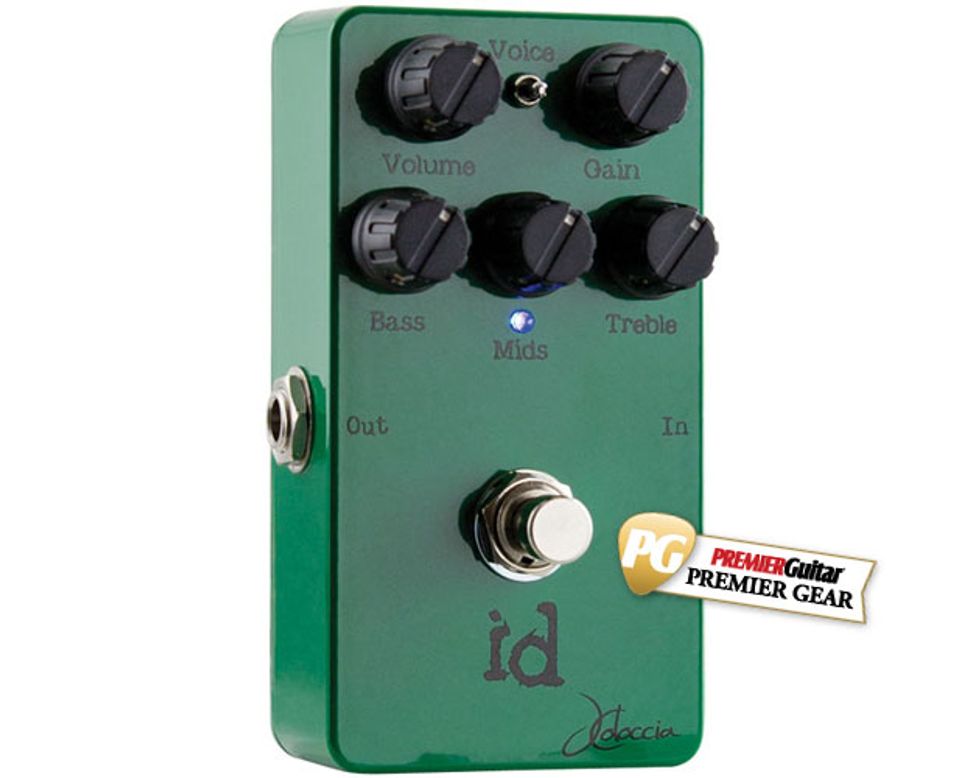
JColoccia ID
Generally speaking, when you see an overdrive clad in green you can be somewhat sure of its spiritual ancestry. (And no, we don’t mean Gumby, Lime Jell-O, or Oscar the Grouch.) No surprise then that when you set the controls on the JColoccia ID at neutral positions, it’s a sonic dead ringer for a Tube Screamer.For a lot of folks, that aural stamp is enough to pique curiosity—especially at a price that’s in line with most mass-produced 808 clones. But what the ID delivers that most 808 clones don’t is a genuinely useful, expanded EQ section that drastically enhances the pedal’s flexibility and delivers unexpected, sometimes very un-808 surprises.
Behind the Green …
For all the extra EQ control that ID puts at your fingertips, the circuit board is very spare, compact, and tidy—taking up less than half the enclosure’s interior space and leaving plenty of room for chassis-mounted input and output jacks, as well as a 9V battery compartment. The EQ controls themselves are a simple set—treble, mid, and bass. It’s a sturdy pedal, with a refreshingly utilitarian feel.
Anyone who loves a good Tube Screamer will feel cozy and at home with the ID. With all controls at noon, it dishes the squishy, present-but-not-spiky midrange that—with a twist this way or that—can convincingly stand in for a screaming tweed or jangling Vox. The big fun begins, however, when you leave the path most trodden and start attacking tone knobs.
Ratings
Pros:
Effectively expands on the TS formula. Great pick sensitivity for a TS-style pedal. Airy high end.
Cons:
None.
Tones:
Ease of Use:
Build/Design:
Value:
Street:
$169
JColoccia ID
jcolocciaguitars.com
The most immediately satisfying departure from tried-and-true TS-ness comes via an inversion of the TS formula—which means, more or less, scooping the midrange and boosting the bass and treble. The transformation that results from this simple adjustment is profound, particularly with single-coil pickups. My Bassman has rarely sounded quite so Marshall-y. And the extra high end enlivens pick attack in a way that might win over the staunchest TS detractors.
Such settings highlight how responsive the ID is to guitar volume attenuation. Adding high end from ID also extends the range of your guitar tone knobs—particularly on Stratocaster- and Les Paul-style control sets where you can set up the individual pickups for radical tone shifts. And finding myself in a Beatles mood, I eagerly and easily moved from scathing, stabbing Revolver chord tones to soft, percolating Abbey Road lead tones using this technique and a two-humbucker Telecaster. In each case the ID lends excited, organic dashes of grit and a jolt of classy, not-too-brutish attitude.
On the back end of a fuzz, ID contributes bulk and aggression without sacrificing overtones. Not surprisingly, it also becomes a very effective equalization tool for a more unruly fuzz or distortion. I tried ID out with a Tone Bender, RAT, Fuzzrite, and Big Muff and the sum total of sounds I could extract from those combinations—and the civility with which ID interacted with each—was super-impressive.
The Verdict
I encounter more polarized opinions about the Tube Screamer these days than ever, but ID is a TS-inspired pedal that could put many related disputes to rest. Use the EQ right and adventurously and you can dial in more air, more punch, and more radical tones than you’ll get out of any 3-knob Tube Screamer. By any standard, however, the ID offers a versatile and satisfying way to dirty up your world.
Watch the Review Demo:
Click onto the next page or select the dirtbox you want to explore next:
Mojo Hand Sacred Cow
Oddfellow The Bishop
Zen Zero Red Crown
Pettyjohn PettyDrive
All Review Demos On One Page
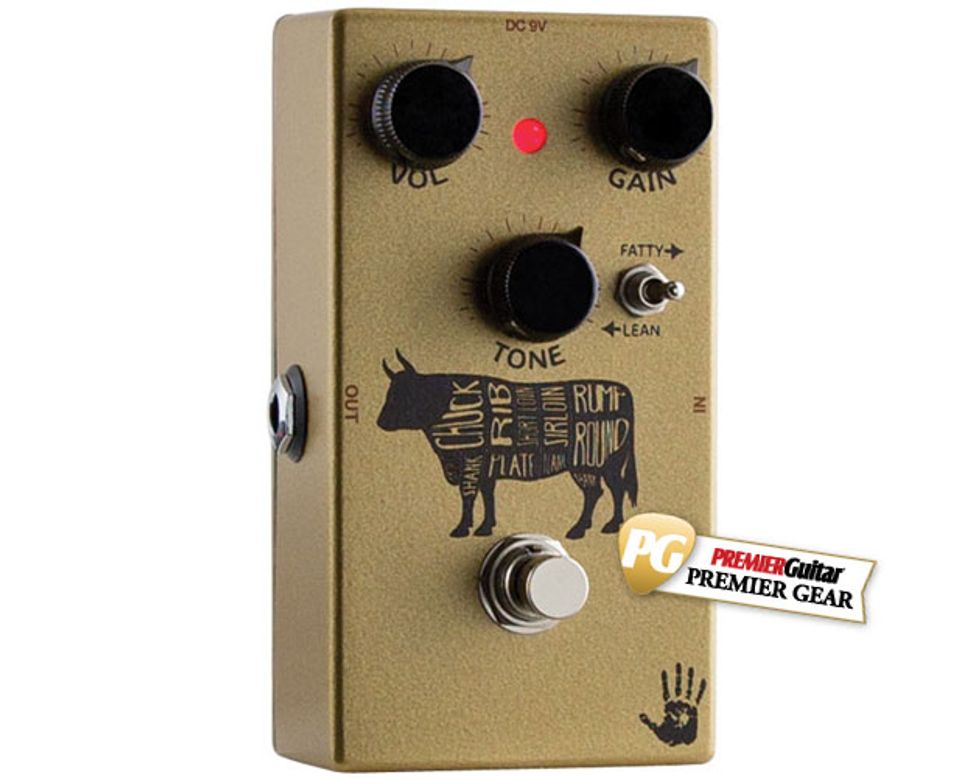
Mojo Hand Sacred Cow
If there’s an upside to the plague called “Klon hype,” it’s that the condition drives builders to duplicate the circuit and sound at (relatively) affordable prices. Better still, it’s compelled a few manufacturers to pursue enhancements and improvements on that now well-codified sonic template. The Mojo Hand Sacred Cow is one of the better fruits of that effort I’ve come across—and we’ve seen many in recent years.Economical Execution, Top Tones
Crack open the Sacred Cow and you see smartly applied economical construction and thoughtful, creative circuit design. Input and output jacks and the AC jack are mounted on the circuit board, though there’s little reason to suspect they are anything other than totally secure. The footswitch itself is mounted apart from the circuit board, which makes replacement easy down the road if necessary. Elsewhere, the circuit is neat and well executed. Texas Instruments op amps and germanium clipping diodes hint at Klon inspiration.
At many equivalent levels, it’s hard to tell the difference between the Sacred Cow and the excellent Klon clone I keep on my own board (which itself is about 95 percent authentic sounding in a head-to-head test with a real-deal Centaur.) But I did hear an ever-so-slight extra airiness and shimmer across the frequency spectrum that I really loved—and that, in fact, might have been the difference between my own klone and the real thing.
Ratings
Pros:
Smooth and tasty take on the Klon recipe. Nice higher gain tones. Big harmonic spectrum.
Cons:
Would be nice to avoid board mounted jacks at this price.
Tones:
Ease of Use:
Build/Design:
Value:
Street:
$179
Mojo Hand FX Sacred Cow
mojohandfx.com
The Sacred Cow shines with essentially clean amps set right at, or just below, the verge of breakup. Low- to medium-gain settings on the pedal yield creamy, harmonic distortion that’s perfect for greasy Stones riffs and snappy lead tones with a just-right softness and glow on the top end. The dynamic shifts you can achieve by clicking the pedal on and off at these settings is akin to the ideal outcome from guitar volume attenuation. But using that technique on top of the Sacred Cow, which is very responsive to guitar volume changes, yields exponentially more color.
Beefier and More Buttery
Higher gain settings highlight what I consider an unsung attribute of Klon-type circuits—a harmonically multifaceted growl that marks that perfect point where “overdrive” and “distortion” shake hands. With Fender single-coils it produces an intoxicating and complex drive tone that’s perfect for punky, grinding chord work. With humbuckers it can give an otherwise mild-sounding 6L6 amp an air of Sabbathoid evil.
Sacred Cow’s most obvious enhancement (apart from delivering authentic Klon-ness at a fair price) is the lean/fatty switch. Lean settings are “normal.” Fatty settings, however, lend low-end heft that almost never obscures the pedal’s lovely high-end detail. It also gives flexibility to players who switch between single-coils and humbuckers, or need extra presence or thump in the course of a set. It’s an addition that genuinely works—one that guitarists are likely to use, rather that leaving in a single, preferred position.
Downstream from my Tone Bender, the Sacred Cow proved to be a great fuzz enhancement, lending punch and the kind of compression and boost you might seek from a nice outboard compressor in a studio. The harmonic depth of the Sacred Cow also makes it a great pairing for delay and reverb textures—exciting ghost harmonics and color in subtle slapback settings, and celestial ambient and shoegaze zones alike. It’s a great pedal for retaining 1st position and barre chord detail amid the blur of reverberations and modulation.
The Verdict
There’s a lot to love about the Sacred Cow. It’s forgiving, flattering, musical, and, in many cases, a touch of magic tone dust. For Klon tones at an accessible price, it’s tough to top.
Watch the Review Demo:
Click onto the next page or select the dirtbox you want to explore next:
JColoccia ID
Oddfellow The Bishop
Zen Zero Red Crown
Pettyjohn PettyDrive
All Review Demos On One Page
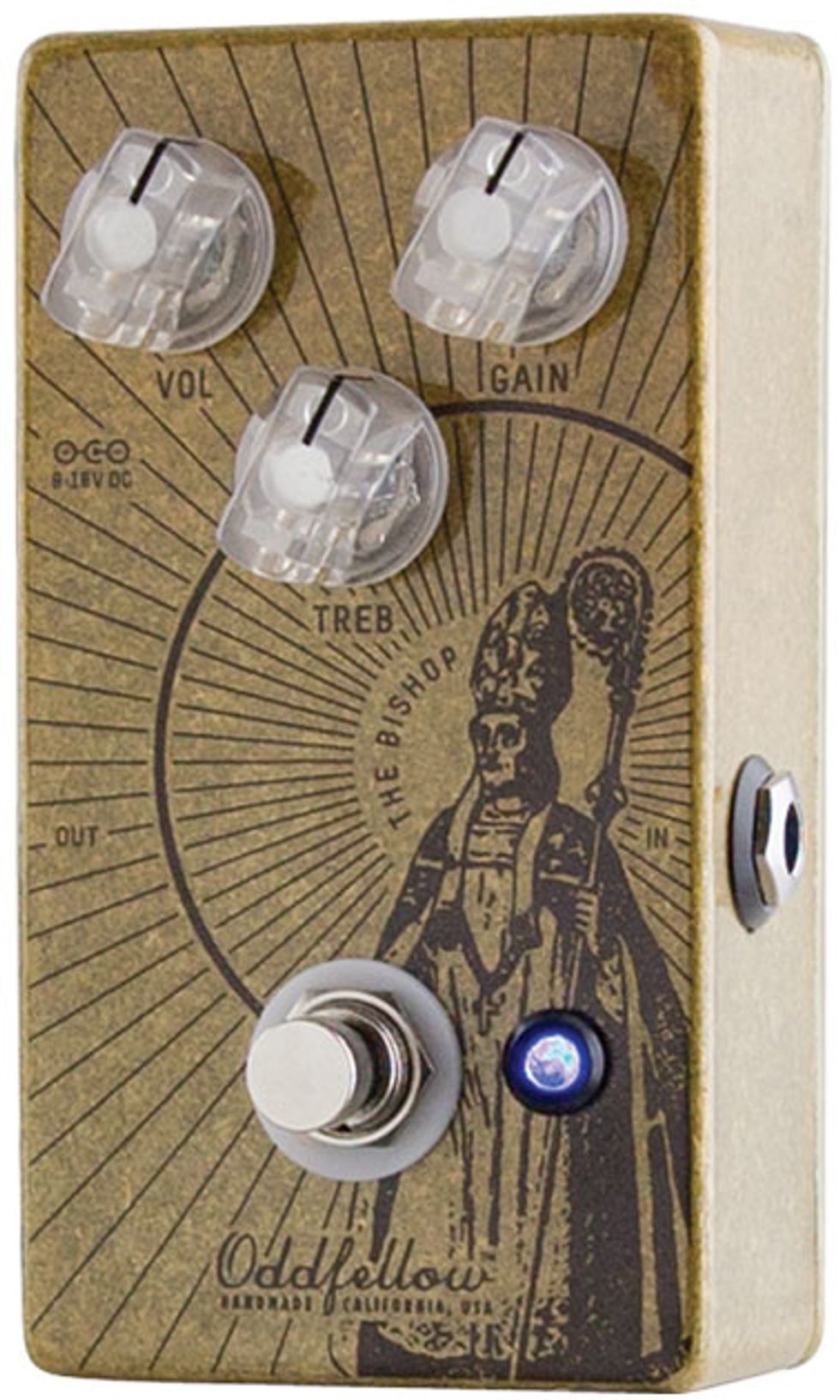
Oddfellow The Bishop
With participants in the great Klon arms race looking beyond the constraints of nailing the Centaur sound, we’re hearing how wonderful variations on the theme can be. Oddfellow’s Bishop makes no specific claims to Klon-ness, but the sonic likenesses are unmistakable and the differences are intriguing, practical, and full of possibilities.Undercover Agendas
Removing the backplate from the Bishop reveals little about the circuit. Oddfellow inverted the circuit board, so you can’t see what components actually populate it. The upside is that you don’t have to hunt for the very practical true bypass/buffer switch. There’s also room for a 9V battery just adjacent to the board-mounted footswitch.
To my ear, the Bishop is fundamentally very Klon-like, though at most settings it dwells on the darker end of the Klon spectrum. At equivalent settings with my own Klon clone, the Bishop is darker and you have to open up the treble by an additional third to get the same airiness and tonality. The differences are more than treble range, though. There’s just a touch of TS-style compression (the kind I really like), and the combination of the darker tendencies and that trace of TS boxiness make the Bishop a killer match for trebly single-coils and hotter humbuckers. It’s also lends softer contours to British amps with a tendency for spiky transients without stripping the signal of top-end punch.
Ratings
Pros:
Nuanced gain control. Airy and detailed at higher tone settings. Nice interactivity between controls. Great with toppy single coils and hot humbuckers.
Cons:
Can sound comparatively boxy at mellower tone settings.
Tones:
Ease of Use:
Build/Design:
Value:
Street:
$165
Oddfellow The Bishop
oddfellowfx.com
The Bishop is not a hair-singeing, high-gain affair. And at first, the gain control can seem to lack range—at least in the sense that it doesn’t flirt with metal distortion textures. Whether this is a plus or minus is totally subjective. But I loved the subtle shades and gradients of distortion that you get in trade. And what the gain control might lack in range, it makes up for in fine-tuning accuracy—especially when you use the equally effective tone control with care.
The fact that the pedal is not too hot also translates to a very nice harmonic balance that highlights the individual components of complex chords very effectively. I could grind out Faces riffs all night for the way the Bishop makes barre chords so intricate-sounding and delicious. And if the Bishop has already lured you into the Ronnie Wood/Keith Richards boogie zone, you’ll find that the pedal’s sensitivity to harmonic intricacies make open-tuned riffs colorful and huge.
The Bishop’s more compressed and less gainy output also works well with additional effects. It can help analog delay repeats nestle more softly and subtly into a mix—I found this pairing especially subtle and sublime—and soften digital repeats. The pedal’s capacity for taming high end also makes it a great companion for a sizzling fuzz.
The Verdict
Like the figure that graces the enclosure and gives this Oddfellow its name, the Bishop is resolutely devout in its mission. It’s not on the fence about whether it’s a distortion or something else. It’s an overdrive that specializes in the subtleties, softer glow, and patina of Peter Green’s tone palette and the classier side of Brit boogie raunch. But it’s also a less macho overdrive in many respects, which makes it a very refreshing alternative for driving digital effects. And while Bishop is completely capable of getting rowdy, its real strength is nuance and a control set sensitive enough to explore that world in depth.
Watch the Review Demo:
Click onto the next page or select the dirtbox you want to explore next:
JColoccia ID
Mojo Hand Sacred Cow
Zen Zero Red Crown
Pettyjohn PettyDrive
All Review Demos On One Page
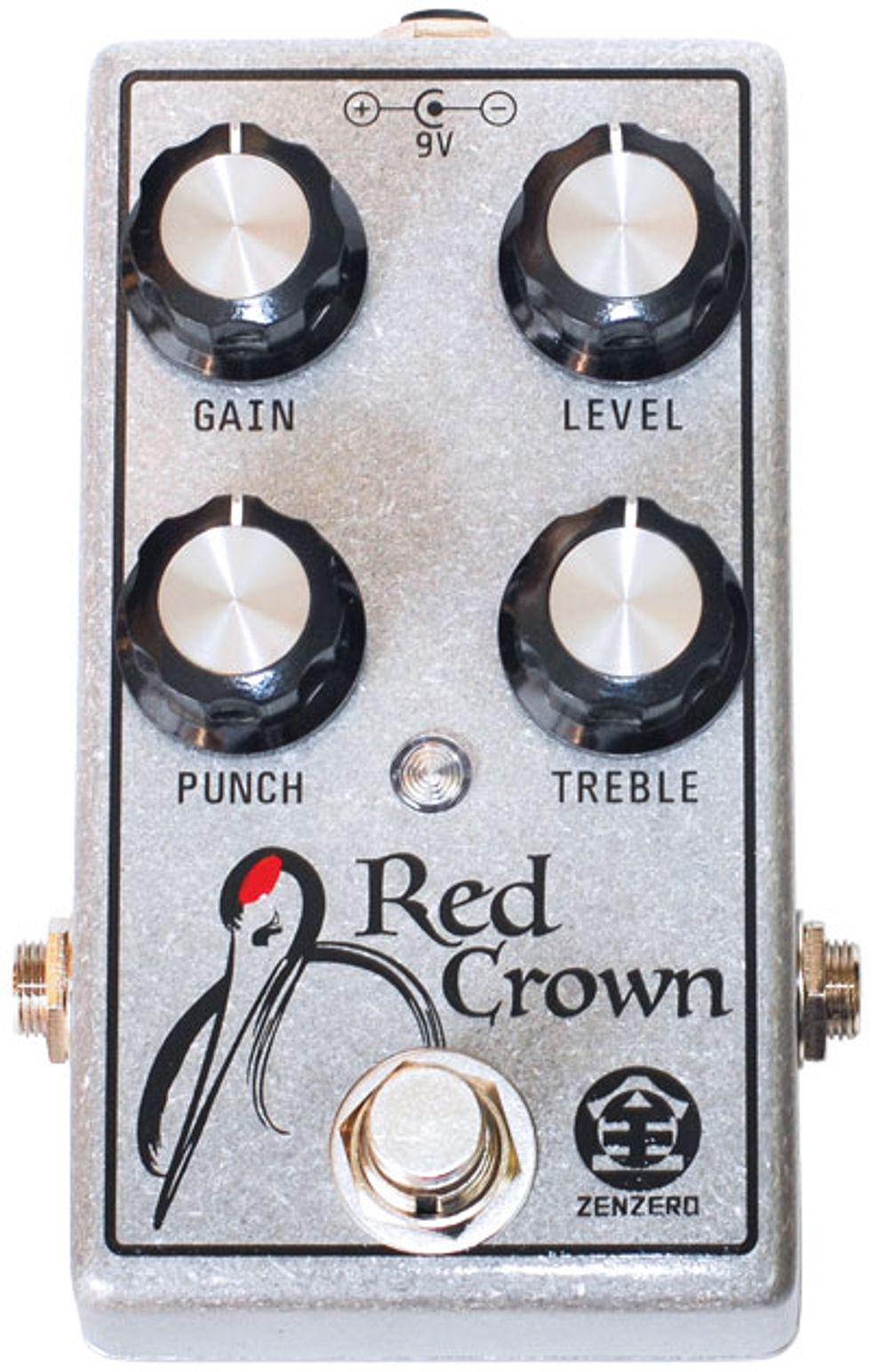
Zen Zero Red Crown
The Red Crown is designed by an Italian guitar nut living in Japan. And if you told us little more, our imaginations would still be fired by the potential tone outcomes of that culture collision. Sure enough, this Zen Zero box sounds quite unlike anything else.Mark of Solidity
Red Crown is a beautifully designed unit—from the elegant, subdued graphics to the soldering within. While you can’t use a battery, the builder positioned input and output jacks lower on the enclosure so you can snuggle the unit closer to pedals with jacks situated at their enclosures’ center points. Inside, the Red Crown is tidy, if a bit crowded. Two notable fixtures include a Texas Instruments LF353 OpAmp and a fat 516D capacitor—another component you don’t see in an overdrive circuit every day. If you guessed we’re headed for unique sonic territory, you’d be right.
Brutishly Big and Toppy
For starters, the Red Crown is loud—very loud. And many of the most impressive, growling overdrive tones are found at impractically loud volumes. How loud is it? I had to dial gain and level settings back to about 9 o’clock or less to achieve unity gain. But for players that like leads to soar above everything else in a mix, or that relish extreme volume shifts within a performance, the Red Crown’s high volume ceiling will be a blessing from the guitar heavens. It’s also a good fit for underachieving small amps, in this respect.
Ratings
Pros:
Rare combination of high output and harmonic complexity. Amazing with neck humbuckers. High-quality construction.
Cons:
Feels way too hot for many applications.
Tones:
Ease of Use:
Build/Design:
Value:
Street:
$185
Zen Zero Red Crown
zenzeroelectronics.com
One of the most interesting things about the Red Crown’s output is that it remains pretty transparent in spite of itself. For single-coil users—especially Stratocaster players who don’t want to sacrifice chime for extra muscle and a bit of dirt—the Red Crown can feel miraculous. It also does magical things with a neck humbucker, and the high gain profile and hot top end mixed with aggressive guitar tone attenuation generates scalding but smooth Cream and David Hidalgo sounds that will sing for an eternity.
Red Crown’s frequency spectrum feels very even for all the excitability in the high-mid and treble zones. It’s much more open and airy than a pedal like a Tube Screamer. And the “punch” control adds emphasis and body to the low end without suffocating the strong trebles. It’s a great feature for thickening thin single-coil output, though in excess it can affect dynamics.
Volume attenuation from your guitar is tricky. You can get nice clean-ish tones by reducing guitar volume, but you may have to roll the knob back to 2 or 3 to get there. There’s a lot of color in between, but it’s trickier to manage than something like a Stratocaster and Marshall, which can go from clean to crunchy with a little nudge of the volume control. With practice, you can get used to the extra range and color. But if you like to shift dynamics with small adjustments, the Red Crown might feel touchy.
For all the extra treble presence, the Red Crown sounds surprisingly great after a fuzz. Common sense says the hot output would turn my Tonebender into a wailing feedback banshee. Counterintuitively, it highlighted some of the loveliest bits of the fuzz frequency spectrum. A Russian Big Muff clone sounded smoother still.
The Verdict
If you’re accustomed to TS- or Klon-style overdrives, the Red Crane’s hot output and top end might sound and feel extreme. The extra high end and surprising transparency can leave you feeling naked if you don’t mind your technique. And though some players might miss that touch of sag and compression that many ODs add to the tone equation, pickers with great technique and timing will love its extraordinary responsiveness.
Watch the Review Demo:
Click onto the next page or select the dirtbox you want to explore next:
JColoccia ID
Mojo Hand Sacred Cow
Oddfellow The Bishop
Pettyjohn PettyDrive
All Review Demos On One Page
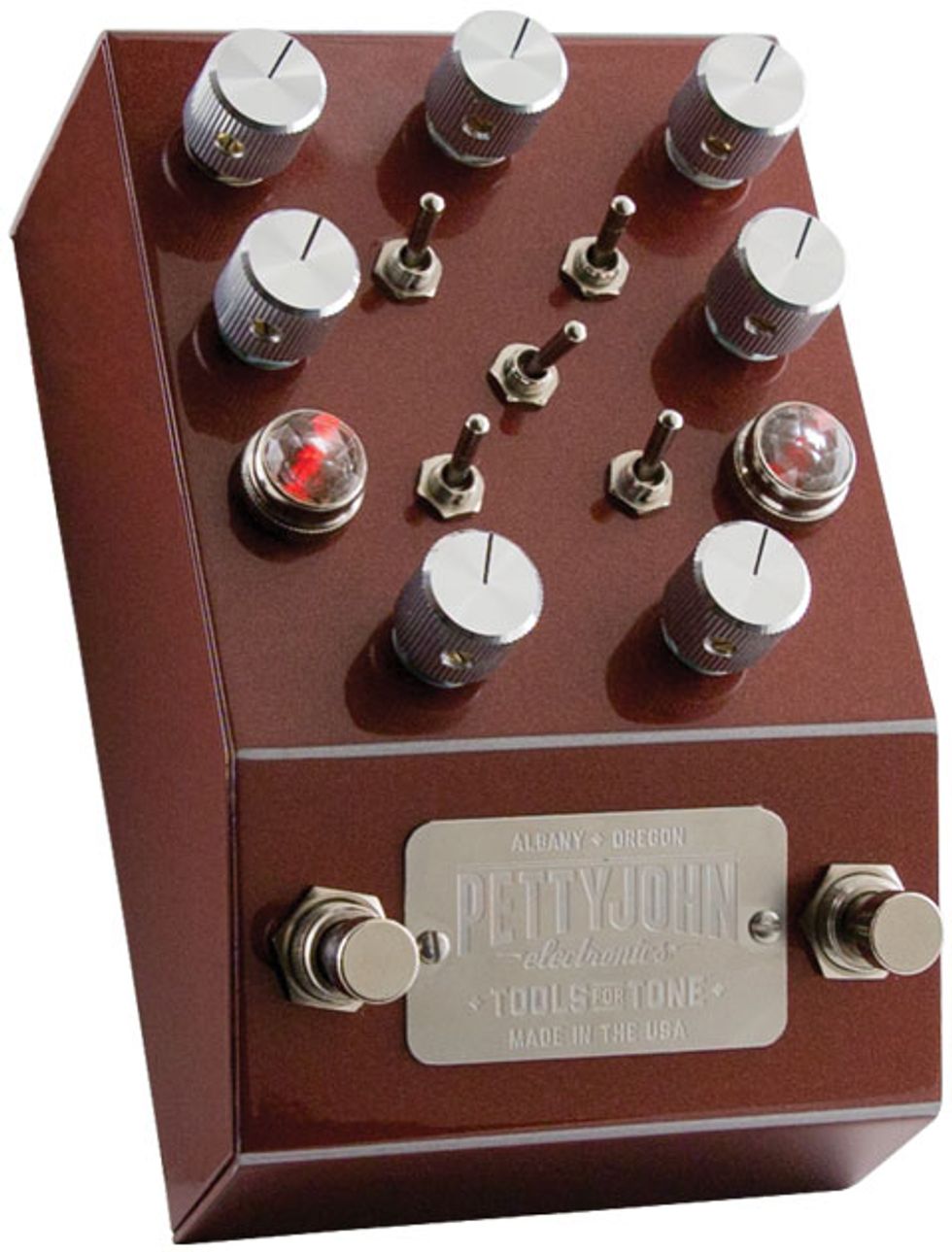
Pettyjohn PettyDrive
The Pettyjohn PettyDrive looks complicated, but with two channels, a parallel effects loop, and multitudinous voice-shaping options, it’s as much a brain or hive for your pedalboard. Remember what we said about overdrive being a pivot around which your whole sound can turn? The PettyDrive very constructively takes that potential to great lengths. And if you’re a control freak or a player that approaches tone with a studio engineer’s mindset, the PettyDrive’s potency is hard to resist.Tone Dispatches from the Mothership
At a glance, the PettyDrive is an indecisive player’s horror show. In actuality, the control layout is quite logical—which is good given that Pettyjohn did not label a single control. Taping the easy-to-eyeball instruction card that comes with the unit to its underside is a pretty good idea.
Essentially, the PettyDrive is made up of two matching sets of controls. Gain, level, and tone for each channel are stacked vertically along each side. One significant difference between the two sets: The lower-gain “chime” channel uses a “tilt” EQ, which boosts treble and cuts bass, or vice versa, simultaneously. The higher-gain “iron” channel uses a simpler high-cut tone control. The top knob is a mix control for the effects loop, which only works with the “iron” channel. Switches include dedicated, three-position low-cut toggles for each channel, plus a clipping diode selector for each channel. You can also flip the order of channels using the center switch.
Ratings
Pros:
Thoughtful design and execution. Top-flight quality. Rock solid. Well-matched drive channels. Endless tone permutations.
Cons:
Expensive. No labels for a complex control array.
Tones:
Ease of Use:
Build/Design:
Value:
Street:
$317
Pettyjohn PettyDrive
pettyjohnlectronics.com
First impressions aren’t very telling when you look inside. Squint and the mass of wires looks like a clown-colored riot. Look closer, though, and you notice what a well-executed, robust build this is. Individual knobs and switches are all chassis-mounted well away from the densely populated circuit board, which is mounted on four strong steel posts on the chassis’ underside. The topside of the unit hints at the ambition in this OD design, but the guts reveal how thoughtfully it is carried out.
Sounds abound in the PettyDrive, and describing every possible permutation or tone would take a review many times this one’s length. But I loved the subtleties and articulate nature of the “chime” channel in particular. It’s a very transparent overdrive and a comparatively low gain channel, which leaves a lot of room for your guitar and amp to speak in their native tongues. Single-coils loved soft clipping on this channel with a little extra bottom from the low-cut selector. The humbuckers in a Telecaster Deluxe sounded best with a little extra low-end cut and a generous heap of high end from the tone knob. Needless to say, the possibilities for dialing in very precise tone profiles for situations like overdubs are vast.
The higher gain “iron” channel is high-gain in a strictly relative sense. In fact, it’s a medium-gain type drive that derives much of its extra heat from the selectable LED and MOSFET clipping sections. And while some players might long for more extreme differences between the two channels, the smaller gain discrepancy means they stack beautifully and can be shaped and chiseled in very precise ways when run together.
The effects loop and the mix knob work brilliantly. And while the PettyDrive sounds great with other effects in series, the very simple process of adding a pedal via the effects loop adds a delicious additional layer of texture.
The Verdict
The PettyDrive probably isn’t an overdrive for the casual player. Adjustments in the heat of performance are tough without practice, and the process of discovering the tones that best fit your rig demands deeper investigation than the average drive pedal. That said, the PettyDrive is surprisingly intuitive and the cornucopia of sounds this thoughtful circuit can produce will thrill the sonically curious.
Watch the Review Demo:
Click onto the next page or select the dirtbox you want to explore next:
JColoccia ID
Mojo Hand Sacred Cow
Oddfellow The Bishop
Zen Zero Red Crown
All Review Demos On One Page
And so you can compare all the pedals at once, here are all the Review Demos in one spot




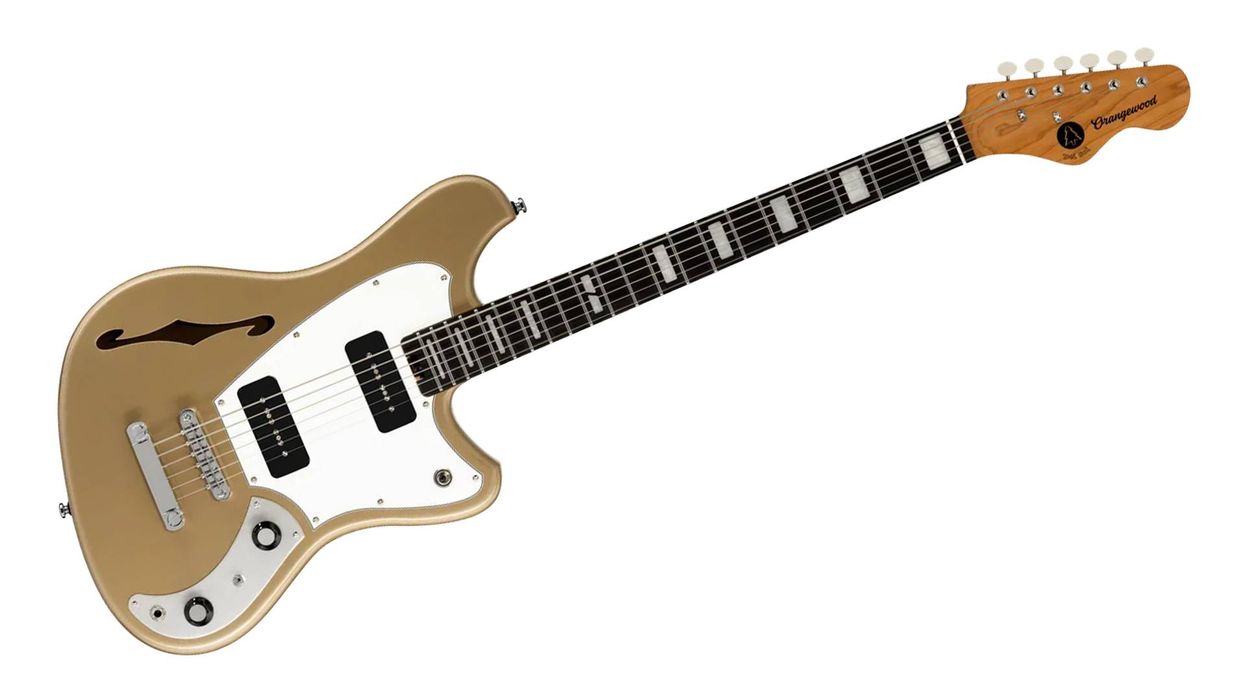



![Rig Rundown: Russian Circles’ Mike Sullivan [2025]](https://www.premierguitar.com/media-library/youtube.jpg?id=62303631&width=1245&height=700&quality=70&coordinates=0%2C0%2C0%2C0)






